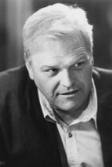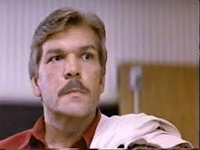As emblematic as Kurt Russell's performance as MacCready in THE THING has become, his was the last role cast. Early on there were general discussions about whether we should stay true to the idea of keeping the movie a strictly ensemble piece or lean in the direction of an established star. I think Kurt was always in the back of John's mind but, having worked twice previously together at this stage in their careers both wanted to keep their options open. These general conversations necessarily involved the studio at this point and were only exploratory, with no commitment from either party implied. My notes from the time aren't complete, but they show that availability was checked on the following actors:
 |
| Christopher Walken |
 |
| Jeff Bridges |
 |
| Sam Shepard |
 |
| Nick Nolte |
Bridges, Nolte and Walken were unavailable or passed without comment very early on. There was the usual initial trouble with the perception that a movie called THE THING could be anything other than a "B" grade sci -fi thriller and it wasn't until actors and agents actually read the script that they warmed to the idea.We were intrigued with Sam Shepard, whom we were told liked the script but things didn't progress very far and no meeting was held. My notes don't reflect it, but I also seem to remember some early interest in Kris Kristofferson...
 |
| John Heard |
 |
| Ed Harris |
 |
| Brian Dennehy |
 |
| Tom Berenger |
 |
| Jack Thompson |
 |
| Scott Glenn |
 |
| Fred Ward |
 |
| Peter Coyote |
 |
| Tom Atkins |
 |
| Tim McIntyre |
These actors met with or read for us for the role of MacCready. John would begin each session with a stern warning about the physical nature of the film and the rigors of working in the cold. Tom Atkins read and was an early favorite of John's when we were thinking solely in terms of "the group". Others, like Scott Glenn and Ed Harris, met but passed soon thereafter. Both Peter Coyote and Tim McIntyre were openly lukewarm about appearing in a monster movie. Brian Dennehy was initially considered but became for a long while the first choice for Copper (switching like this was not unusual. Richard Masur came in originally for the role of Bennings, but expressed interest in Clark, for example).
Australian actor Jack Thompson, then currently starring in BREAKER MORANT was a surprisingly strong late contender for MacCready. The film was shown to the studio and he was flown in to read for John in his office, but in the end what seemed to be the best fit and make the most sense was staying with Kurt, a decision no one has regretted since...
John made the decision to cast Kurt on the day we left to film the initial ice field sequences above Juneau in early June, 1981. There he also shot the footage of Mac flying to the Norwegian Camp and the flying saucer ( the helicopter pilot filling in ), an occasion as I think he has pointed out where he filmed the costume before he filmed the actor...
























.jpg)



.jpg)
.jpg)





.jpg)

















